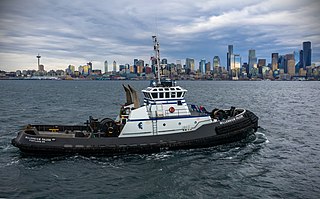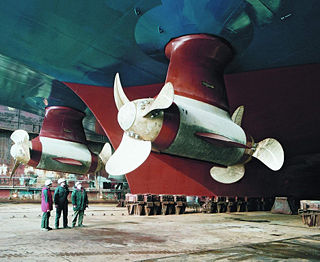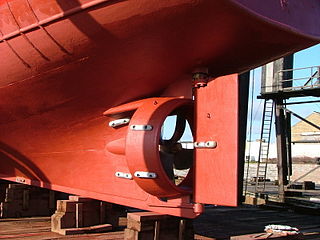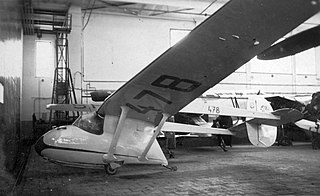A Schilling rudder is a specific type of profiled rudder used on certain boats and ships.
Contents

A Schilling rudder is a specific type of profiled rudder used on certain boats and ships.

The Schilling profile is designed to improve the effective lift generated by the rudder and hence improve the maneuverability of the craft, especially at slow speeds. The rudder is effective in both forward and reverse. It has been claimed that a Schilling rudder "combines the highest lateral forces with the best course stability. [1]
Like all rudders, the main effect of a Schilling rudder is to deflect the flow of water generated by the propeller. Schilling rudders are most commonly used on ships that are difficult to maneuver, particularly large ships such as container ships and oil tankers, slow-moving ships and boats, longer and narrower ships, or boats with slow-moving propellers. [2]
Additionally, a twin-rudder configuration and/or a bow thruster can significantly contribute to the maneuverability of even the largest ships. When the rudders are at angles of 90 degrees or more to the direction of the propeller generated thrust, they can direct the thrust forward and provide a significant braking effect on the ship.
There is little reliable information available in the public domain regarding the exact shape of the Schilling rudder. However, the basic shape is a relatively simple ‘fish shape’ if viewed from above (as seen in the figure to the right). Also, pair of flat plates are typically fitted top and bottom to prevent or minimize end-effect on the aerofoil.



The basic principle proportions of a typical Schilling rudder layout are as follows:
Or in other words, a bulbous widening for 1/5 of the total length of the rudder blade, with a streamlined narrowing for 2/5 of the length leading to a flat section lasting for around 1/5 of a cord-length, finalizing in a blunt-ended flared trailing edge for the remaining fifth.
The width of the trailing edge should be 33% of the maximum width of the profiles. The width of the end plates to be around twice the maximum width of the rudder.
The height should be similar to the diameter of the propeller, with the chord length being up to 1.2 × propeller diameter. If extreme maneuverability is not required, chord length can be reduced to a minimum of 0.55 × propeller diameter.
Around 40% balance should be provided, aka, rudder in front of the rudder pivot.
The distance from the trailing edge of the propeller to the leading of the rudder should be a minimum of 0.2 × propeller diameter, and the maximum effective angle of operation for a single rudder is 2*70 degrees.
No information as to the layout or profile design of a twin rudder system is contained within this article.
Rudders of the same or similar profile are also referred to as the MacLear-Thistle or Mystic rudder.
Alternatives to the Shilling rudder concept include conventional aerofoil shapes, i.e. without the flared end, flap rudders, Kort nozzles and azimuth thrusters.

A propeller is a device with a rotating hub and radiating blades that are set at a pitch to form a helical spiral, that, when rotated, performs an action which is similar to Archimedes' screw. It transforms rotational power into linear thrust by acting upon a working fluid, such as water or air. The rotational motion of the blades is converted into thrust by creating a pressure difference between the two surfaces. A given mass of working fluid is accelerated in one direction and the craft moves in the opposite direction. Propeller dynamics, like those of aircraft wings, can be modelled by Bernoulli's principle and Newton's third law. Most marine propellers are screw propellers with helical blades rotating on a propeller shaft with an approximately horizontal axis.

In aeronautics, a chord is the imaginary straight line joining the leading edge and trailing edge of an aerofoil. The chord length is the distance between the trailing edge and the point where the chord intersects the leading edge. The point on the leading edge used to define the chord may be either the surface point of minimum radius or the surface point that maximizes chord length.

A tugboat or tug is a type of vessel that maneuvers other vessels by pushing or pulling them either by direct contact or by means of a tow line. Tugs typically move vessels that either are restricted in their ability to maneuver on their own, such as ships in a crowded harbor or a narrow canal, or those that cannot move by themselves, such as barges, disabled ships, log rafts, or oil platforms. Tugboats are powerful for their size and strongly built, and some are ocean-going. Some tugboats serve as icebreakers or salvage boats. Early tugboats had steam engines, but today most have diesel engines. Many tugboats have firefighting monitors, allowing them to assist in firefighting, especially in harbors.

A rudder is a primary control surface used to steer a ship, boat, submarine, hovercraft, aircraft, or other conveyance that moves through a fluid medium. On an aircraft the rudder is used primarily to counter adverse yaw and p-factor and is not the primary control used to turn the airplane. A rudder operates by redirecting the fluid past the hull (watercraft) or fuselage, thus imparting a turning or yawing motion to the craft. In basic form, a rudder is a flat plane or sheet of material attached with hinges to the craft's stern, tail, or after end. Often rudders are shaped so as to minimize hydrodynamic or aerodynamic drag. On simple watercraft, a tiller—essentially, a stick or pole acting as a lever arm—may be attached to the top of the rudder to allow it to be turned by a helmsman. In larger vessels, cables, pushrods, or hydraulics may be used to link rudders to steering wheels. In typical aircraft, the rudder is operated by pedals via mechanical linkages or hydraulics.

An airfoil or aerofoil is the cross-sectional shape of a wing, blade, or sail.

An azimuth thruster is a configuration of marine propellers placed in pods that can be rotated to any horizontal angle (azimuth), making a rudder unnecessary. These give ships better maneuverability than a fixed propeller and rudder system.

A propulsor is a mechanical device that gives propulsion. The word is commonly used in the marine vernacular, and implies a mechanical assembly that is more complicated than a propeller. The Kort nozzle and pump-jet are examples.

The Voith Schneider propeller (VSP), also known as a cycloidal drive is a specialized marine propulsion system (MPS). It is highly maneuverable, being able to change the direction of its thrust almost instantaneously. It is widely used on tugs and ferries.

A Z-drive is a type of marine propulsion unit. Specifically, it is an azimuth thruster. The pod can rotate 360 degrees allowing for rapid changes in thrust direction and thus vessel direction. This eliminates the need for a conventional rudder.

Manoeuvring thruster is a transversal propulsion device built into, or mounted to, either the bow or stern, of a ship or boat to make it more manoeuvrable. Bow thrusters make docking easier, since they allow the captain to turn the vessel to port or starboard side, without using the main propulsion mechanism which requires some forward motion for turning; The effectiveness of a thruster is curtailed by any forward motion due to the Coandă effect. A stern thruster is of the same principle, fitted at the stern. Large ships might have multiple bow thrusters and stern thrusters.
Variable camber is a feature of some of aircraft wings that changes the camber of the main aerofoil during flight.

A radio-controlled boat is a boat controlled remotely with radio control equipment.

The Kitchen rudder is the familiar name for "Kitchen's Patent Reversing Rudders", a combination rudder and directional propulsion delivery system for relatively slow speed displacement boats which was invented in the early 20th century by John G. A. Kitchen of Lancashire, England. It turns the rudder into a directional thruster, and allows the engine to maintain constant revolutions and direction of drive shaft rotation while altering thrust by use of a control which directs thrust forward or aft. Only the rudder pivots; the propeller itself is on a fixed shaft and does not.

The Pleuger rudder is a power assisted ship's rudder. It creates a flow of water in the direction the rudder points powered by an auxiliary electric motor. This aids maneuverability at low speeds greatly, since it operates on a similar principle to a thruster.

A ducted propeller, also known as a Kort nozzle, is a marine propeller fitted with a non-rotating nozzle. It is used to improve the efficiency of the propeller and is especially used on heavily loaded propellers or propellers with limited diameter. It was developed first by Luigi Stipa (1931) and later by Ludwig Kort (1934). The Kort nozzle is a shrouded propeller assembly for marine propulsion. The cross-section of the shroud has the form of a foil, and the shroud can offer hydrodynamic advantages over bare propellers, under certain conditions.
The Gouge flap, invented by Arthur Gouge of Short Brothers in 1936, allowed the pilot to increase both the wing area and the chord of an aircraft's wing, thereby reducing the stalling speed at a given weight. This provided the benefit of a shorter takeoff distance for a given load, a shorter distance to achieve a given height and a lower takeoff speed. This type of flap, in spite of its use on successful aircraft such as the Short Sunderland and the Short Stirling, was limited to use on aircraft produced by Short Brothers.
A Flap Rudder is a specific type of multi-section rudder used on boats and ships. The hinged aft section gives the rudder an extra control surface, enhance its efficiency.

The RFB X-113 Aerofoil Boat was an experimental ground effect vehicle intended to work over water. It was one of three such aircraft designed by Alexander Lippisch in the 1960s and early 1970s. The X-113 first flew in 1970; only one was built.

The ITS-8 was a Polish twin-boom motor glider flown in 1936. Two prototypes were completed but production was prevented by the German invasion of Poland in 1939.